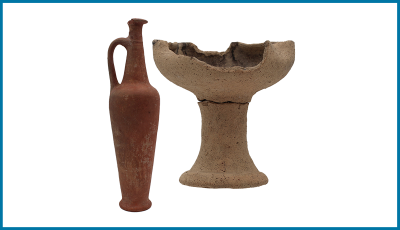
Ancient Syria: The City of Ugarit Comes to Life
Thursday, February 22, 2024
VDA Suite (Hannon Library)
5:30 - 7:30 p.m.
- About The Exhibit
- Our Sponsors
-
Ancient Syria: The City of Ugarit Comes to Life
The ancient city of Ugarit was located along the coast of the Mediterranean sea in modern-day northern Syria. The city, capital of a kingdom of the same name, was occupied continuously from the late 8th to the late 2nd millennium BC, but it is best known for the remains from the Late Bronze Age (c. 1550-1200 BC). The city was violently destroyed in 1180 BC and was never reoccupied. The kingdom of Ugarit was situated in an ideal location, at the junction of two routes linking the coast and inner Syria and running along the Mediterranean. Because of this felicitous position, its natural resources, and its well-sheltered main harbor at Minet el-Beida, Ugarit experienced great prosperity and played a key role on the international scene; this is shown by imported materials found at the site, as well as by international diplomatic correspondence and treaties.
Minet el-Beida was discovered accidentally in 1928, and excavations under the supervision of French archaeologist Claude Frédéric-Armand Schaeffer started in 1929. Exploration there soon revealed a Late Bronze Age settlement connected to the larger site on the tell of Ras Shamra, some 800 m inland.
The excavations have exposed a palace, temples, houses, and streets, and yielded a wealth of finds (gold, ivory, stone vases, and numerous local and imported ceramics), including archives of tablets inscribed both in Mesopotamian logo-syllabic cuneiform and in a native Ugaritic cuneiform alphabet, one of the earliest alphabet ever used. The Ugaritic language and alphabet were used primarily for writing administrative records, letters, ritual texts, and mythological poetry, notably poems about important Syro-Canaanite deities such as El, Asherah, Ba‘al, and Anat. Strong connections between Ugarit myths and the Bible have been noted by scholars, and the site is important both for archaeologists, and Biblical scholars. This exhibit was designed by LMU students enrolled with Dr. Sauvage in CLAR 4374 “The Late Bronze Age City of Ugarit and its Material Culture” in Fall 2023.
About the Bellarmine Forum
The Bellarmine Forum is LMU's annual celebration of the life of the mind, offered by the Bellarmine College of Liberal Arts. The 2023-24 Bellarmine Forum invites students, faculty, and the entire LMU community to think about how we understand “internationalization” and how to break it down into what that actually means to us.
This exhibit was made possible by a generous loan from Claremont Graduate University; Special Collections and Archives at the Honnold Library for the Claremont colleges, and Joy Robinson.
